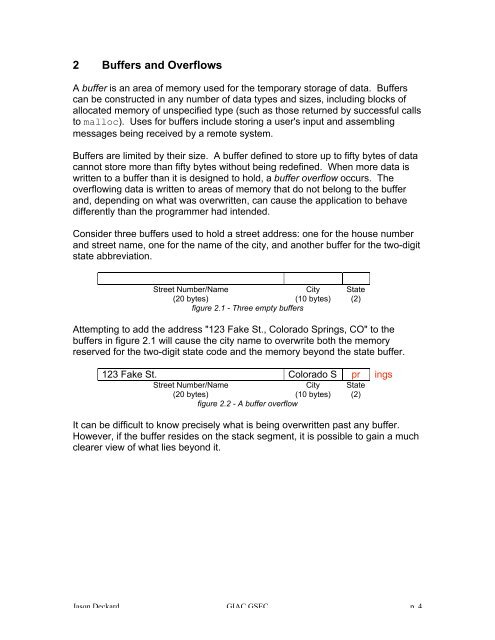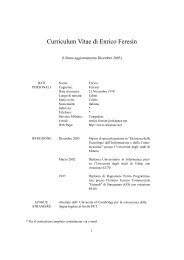Defeating Overflow Attacks - orkspace.net
Defeating Overflow Attacks - orkspace.net
Defeating Overflow Attacks - orkspace.net
Create successful ePaper yourself
Turn your PDF publications into a flip-book with our unique Google optimized e-Paper software.
2 Buffers and <strong>Overflow</strong>s<br />
A buffer is an area of memory used for the temporary storage of data. Buffers<br />
can be constructed in any number of data types and sizes, including blocks of<br />
allocated memory of unspecified type (such as those returned by successful calls<br />
to malloc). Uses for buffers include storing a user's input and assembling<br />
messages being received by a remote system.<br />
Buffers are limited by their size. A buffer defined to store up to fifty bytes of data<br />
cannot store more than fifty bytes without being redefined. When more data is<br />
written to a buffer than it is designed to hold, a buffer overflow occurs. The<br />
overflowing data is written to areas of memory that do not belong to the buffer<br />
and, depending on what was overwritten, can cause the application to behave<br />
differently than the programmer had intended.<br />
Consider three buffers used to hold a street address: one for the house number<br />
and street name, one for the name of the city, and another buffer for the two-digit<br />
state abbreviation.<br />
Street Number/Name<br />
City<br />
(20 bytes)<br />
(10 bytes)<br />
figure 2.1 - Three empty buffers<br />
State<br />
(2)<br />
Attempting to add the address "123 Fake St., Colorado Springs, CO" to the<br />
buffers in figure 2.1 will cause the city name to overwrite both the memory<br />
reserved for the two-digit state code and the memory beyond the state buffer.<br />
123 Fake St. Colorado S pr ings<br />
Street Number/Name<br />
City<br />
(20 bytes)<br />
(10 bytes)<br />
figure 2.2 - A buffer overflow<br />
State<br />
(2)<br />
It can be difficult to know precisely what is being overwritten past any buffer.<br />
However, if the buffer resides on the stack segment, it is possible to gain a much<br />
clearer view of what lies beyond it.<br />
Jason Deckard GIAC GSEC p. 4






